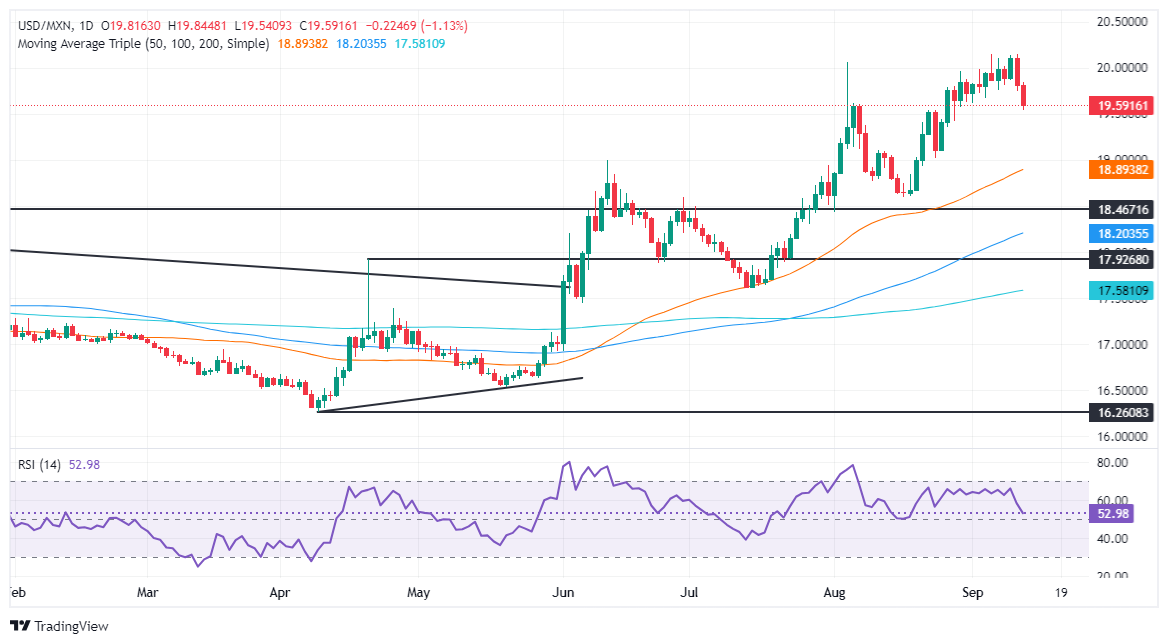Mexican Peso jumps despite reform approval, weak US Dollar

- Mexican Peso climbs after judiciary reform approval with state-level voting underway to finalize the constitutional change.
- Moody’s warns the reform could threaten Mexico’s judicial independence and impact the country’s credit rating.
- Mixed US economic results reduce likelihood of a 50 bps Fed rate cut with upcoming US Consumer Sentiment data in focus.
The Mexican Peso rallied sharply against the Greenback on Thursday following the approval of the judiciary reform on Tuesday. US economic data showed mixed readings, with an uptick in factory inflation and soft jobs data. The USD/MXN trades at 19.46, down over 1.60%.
Mexico’s political turmoil has faded, though the approval of the judicial reform is a certainty. Congresses in 32 states began the approval process, and once voted by a majority in 17 states, it will be declared a law. Aside from this, the economic docket is empty. The next economic release comes on September 18, when INEGI will reveal Aggregate Demand and Private Spending data.
Regarding the judicial reform, Moody’s warned of its impact on Mexico’s credit rating. An analysis emphasizes that “the constitutional change threatens the independence and impartiality of Mexico’s judiciary” and “would undermine sovereign credit quality.”
The Greenback remained offered in the US after the US Bureau of Labor Statistics (BLS) revealed that the August Producer Price Index (PPI) figures were mixed. At the same time, the number of Americans filing for unemployment benefits rose as estimated and cleared the previous week’s reading.
After the latest consumer and producer inflation reports in the US, expectations for a 50-basis-point (bps) rate cut by the Federal Reserve (Fed) were trimmed. The chances for a 50 bps cut are 15%, while for a 25 bps cut they are 85%, via CME FedWatch Tool data.
USD/MXN will eye the Consumer Sentiment survey released by the University of Michigan on Friday.
Daily digest market movers: Mexican Peso on the front foot after judicial reform approval
- Mexico’s Industrial Production in July offered mixed readings, yet most economists estimate an economic slowdown.
- Inflation in August dipped below the 5% threshold and augmented speculation of additional easing by the Bank of Mexico (Banxico).
- September’s Citibanamex Survey showed that Banxico is expected to lower rates to 10.25% in 2024 and to 8.25% in 2025. The USD/MXN exchange rate is forecast to end 2024 at 19.50 and 2025 at 19.85.
- BLS revealed that PPI in August rose by 1.7%, below estimates of 1.8%, and core PPI rose from 2.3% to 2.4%, beneath expectations of 2.5%.
- Headline PPI and core increased compared to the previous month’s reading. PPI exceeded expectations of 0.1%, expanded by 0.2%, and core PPI rose by 0.3%, up from 0.2%.
- Data from the Chicago Board of Trade suggests the Fed will cut at least 98 basis points this year, up from 108 a day ago, according to the fed funds rate futures contract for December 2024.
USD/MXN technical outlook: Mexican Peso surges as USD/MXN slumps below 19.60
The USD/MXN uptrend remains in place on Thursday despite the ongoing correction for the last two days. Momentum shifted negatively in the pair, as shown by the Relative Strength Index (RSI). This is despite the approval of an unwelcome judicial reform that foreign investors, banks and credit agencies opposed.
In the meantime, the USD/MXN is headed to the downside in the short term. The first support would be the 19.50 area. Once cleared, the next support would be the August 23 swing low of 19.02, shy of the 50-day Simple Moving Average (SMA) at 18.99.
Conversely, the USD/MXN must clear the psychological 20.00 figure for a bullish continuation. If surpassed, the next ceiling level would be the YTD high at 20.22. On further strength, the pair could challenge the daily high of September 28, 2022, at 20.57. If those two levels are surrendered, the next stop would be the swing high at 20.82 on August 2, 2022, ahead of 21.00.
Economic Indicator
Industrial Output (YoY)
The Industrial Output released by the INEGI shows the volume of production of Mexican industries such as factories and manufacturing. An uptrend is regarded as inflationary which may anticipate interest rates to rise. If there is industrial production growth, this may generate a positive (or bullish) sentiment for the Mexican Peso.
